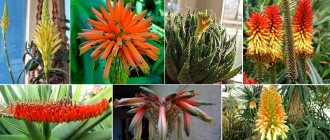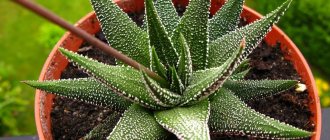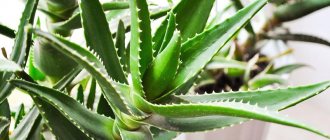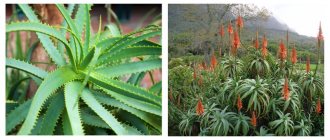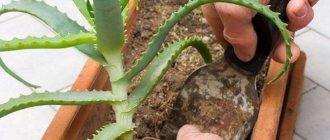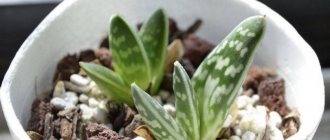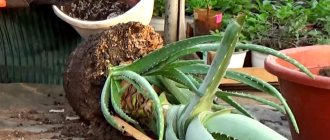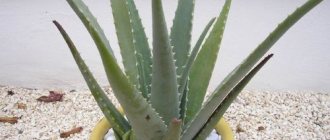A little about aloe
Aloe is a plant that grows both at home and in the wild. From this article you will learn what types there are, how to care for them, recipes for diseases and contraindications. It is important to know that the leaves also contain toxic substances, so you need to understand that you can only use the plant if you have complete information about it.
Aloe is a succulent plant of the Asphodelaceae family, which contains 400-500 species. They can reach a height of up to 10 meters and can also be small house plants. The plant has thick sword-shaped leaves and each leaf is equipped with thorns along the edges.
In nature, the leaves of the plant serve to accumulate moisture. The homeland of the species is Africa. There are many species that grow in Madagascar and the Arabian Peninsula. Life expectancy at home is from 5 to 20 years. All cultural species are perfect for landscaping an apartment.
Growing problems
Aloe tree, or agave, unfortunately, often suffers in our apartments. It is rather grown for medicinal purposes, regularly plucked and given little care. But if you grow this plant correctly and do not cut off its leaves, you can get very beautiful specimens.
Most often, aloe plants suffer from excess moisture; if watering is too frequent, the roots rot and the plant dies. Aloe plants also often suffer from lack of sunlight, especially in winter. At the same time, their stems are elongated, the leaves are smaller and sit less frequently on the trunk. On the contrary, on western or southwestern window sills, aloe may lose its decorative effect - the leaves turn red and become thinner, but as soon as it is moved to a more gentle sun (eastern or northwestern side), the bush turns green again.
This plant does not benefit from planting in heavy clay soil. Moisture evaporates poorly and there is no aeration, and soil that dries out for a long time inevitably leads to the formation of rot.
If you ask about pests, any granny who grows agave will be surprised - most likely, she has never heard that it has pests. And if something withers, we’ll root a branch and grow a beautiful bush again. In fact, pests such as mealybugs and scale insects can appear on aloe. Both are easy to spot. Scale insects look like white cotton balls in the axils of the leaves, under the husk of old dead leaves on the trunk, and scale insects are noticeable on leaves wrinkled from lack of moisture and nutrition as brownish pimples, sometimes translucent. If you notice something similar on aloe, you need to thoroughly rinse the plant and wipe with a soapy sponge. Then rinse, spray and water with aktar solution. Repeat treatment after a week.
Chemical composition of leaves
This is a unique plant. It contains about 250 active biological substances. The plant has no equal among representatives of this flora. The main component of the leaves is water (97%).
Also, the leaves of this plant may contain:
- Esters
- Essential oils
- Phytoncides
- Flavonoids
- Tannins
- Beta carotene
- Anthraglycosides
- Anthraquinone
- Allantoin
- Polysaccharides
- Monosaccharides
- Amino acids: glycine, glutamic acid, etc.
- Vitamins: A, B1, B2, B3, B6, B9, C, E
- Simple organic acids (malic, citric, succinic, etc.)
- Microelements: selenium, calcium, potassium, magnesium, iron, phosphorus, manganese and others.
Description of the plant, how aloe vera differs from agave
A thick trunk, fleshy leaves with prickly tips extending from it, arranged like branches on a tree - a description of my grandmother’s flower, which stood in all the apartments of our country for decades.
The popular name of this plant is agave; in the scientific classification the term is used - aloe vera.
This species grows in greenhouse conditions and is not able to tolerate temperatures below 12 degrees.
Aloe vera has the same climate requirements. Unlike agave, the leaves of the plant emerge from a single point - the base of the plant. One of the names of this succulent is agave. Its leaves are much wider and thicker than the leaves of the agave.
As for the beneficial properties, the chemical composition of both types is practically the same.
The juice and pulp of the leaves of both types are very bitter in taste; the name itself translates as “bitter”.
Experiments conducted by Italian scientists revealed an interesting detail about domestic and uncultivated aloe. According to the data obtained, the leaves of the domestic plant contain at least double the dose of nutrients compared to its uncultivated counterpart.
Kinds
Plants are herbaceous, shrubby and tree-like. Of the many types, the most famous are:
Tree-like (Aloe arborescens)
Under natural conditions, this plant reaches a height of up to 3 meters. This particular plant is called agave. An evergreen succulent plant of the Asphodelaceae family. Its natural range covers South Africa: Mozambique, Zimbabwe, Swaziland and Malawi.
It has wide medical uses and is also cultivated as an ornamental houseplant. It was known as a medicinal plant back in Ancient Egypt, where, along with medicinal use, it was used in means for embalming the dead.
Spinous (Aloe aristata)
A perennial herbaceous succulent plant with thick, fleshy leaves collected in dense rosettes and arranged in a spiral. The diameter of the rosettes can reach 60 cm. The surface of the leaves is rough, with small white spots; edges with small spines. Grown as a houseplant.
Quiver (Aloe dichotoma)
This is a trembling tree or kokerboom. It reaches a height of up to 9 meters, the branched trunk reaches 1 m in circumference. Aloe quiver is a symbol of the south of Namibia. The quiver tree is also found in the desert regions of Angola.
Folded (Aloe plicatilis)
Woody or shrubby plant from the Asphodelaceae family. It is a small tree or shrub. Height 3-5 m. Stems forked. The leaves have an unusual shape: on the branches they are arranged in 2 rows like a fan, each of which has 10-16 leaves. Distributed in South Africa.
This is what aloe vera looks like at home
Variegated (Aloe variegata)
Aloe variegated, or tiger, is a perennial herbaceous succulent plant of the Asphodelaceae family. Distributed in South Africa and Namibia. The specific epithet variegata comes from the Latin, meaning "variegated" and refers to the plant as a mottled-leaved species.
The plant is 20-30 cm high, with 18-24 leaves arranged in 3 rows. The leaves are lush green in color, with uneven light green areas. The length of the leaves is 10-15 cm, the width at the base is about 3-6 cm. The shape of the leaves is triangular. Depending on injury, amount of water and age, the outer leaves will die off, turning a golden brown color.
Vera (Aloe vera)
Aloe vera, or Aloe Vera, is a succulent herbaceous plant of the Asphodelaceae. Widely used in medicine and cosmetics. In terms of chemical composition and medicinal use, this type of aloe is close to aloe vera.
This species has become established in the southern half of the Arabian Peninsula, in North Africa (Morocco, Mauritania, Egypt), as well as in Sudan, the Canary Islands, Cape Verde, and the island of Madeira. The plant grows wild in the Canary Islands. This plant can survive in conditions where others wither and die. In extreme situations, it closes the pores, trapping moisture inside the leaf.
Descoingsii (Aloe descoingsii)
Homeland - dry areas of Africa, Mascarene Islands, Madagascar and adjacent islands, in the south of the Arabian Peninsula. The smallest and most light-loving plant.
This herbaceous plant is distinguished by a shortened stem with leaves in the shape of an elongated triangle, collected in basal rosettes. During flowering, orange buds appear on a separate peduncle.
Frightening (Aloe ferox)
Aloe intimidating is one of the types of medicinal plants. It is distinguished by its external appearance, which is unusual for this shrub. Usually it grows tall, having a strong stem on which spiky, dense leaves are arranged in a checkerboard pattern. The intimidating appearance is a rosette of strong, long, fleshy leaves. The plant can reach 2 meters in height.
Botanical description
Aloe (lat. Aloe) - has up to 260 species of herbaceous perennials belonging to the Asphodelaceae family. The homeland of aloe is Africa, and in arid zones. But this is not a problem for aloe - it tolerates lack of moisture well. Aloe leaves are often fleshy, grow from the root, and are collected in a rosette. There are species with thorns on the leaves, and others without thorns. The leaves of some species are covered with a waxy coating. Aloe blooms with flowers of yellow, red or orange shades. Flowers, depending on the species, are collected in paniculate or racemose inflorescences, and are usually tubular or bell-shaped. Some types of aloe are used in medicine, because... Some types of aloe have beneficial properties. The juice is used in the treatment of burns and ulcers. Aloe juice has a rejuvenating and restorative effect on the skin. A substance that has a laxative effect is obtained from the leaves. A large number of species and varieties are grown in indoor floriculture.
Caring for tree Aloe, agave
This is a fairly hardy and unpretentious plant. Caring for agave is not at all difficult. It is enough to follow the basic rules of caring for this plant.
Illumination
The plant is light-loving, but it will not disappear even if it stands in the shade. In a dark space, aloe begins to stretch and its leaves turn white. In summer, it is better to take aloe to the balcony; such a plant grown in the fresh air will have stronger and better formed stems and spines. But you need to make sure that the aloe is not exposed to rain.
Watering
In summer, you need to water the agave every other day, but in winter it is rare (once a week) and with water at room temperature. The plant has thick roots that can take up the entire space of the pot, and therefore water quickly flows into the tray. In this case, it makes sense to pour water into the pan; the roots will absorb the water. An hour after watering, you can look into the pan and if there is water left, pour it out, otherwise the roots may rot.
Air humidity
Air humidity does not play a special role. But it is useful to periodically wipe the leaves with a damp cloth.
Top dressing
The plant needs to be fertilized once in spring and summer with a weak solution of mineral fertilizer. In autumn and winter, aloe is not fed.
Transfer
Young plants need to be replanted annually. Adult aloe plants are replanted every 2-3 years as needed. The pots must be deep and the pot must have drainage.
The soil
There are ready-made mixtures for aloe and other succulent plants. But it is advisable to add charcoal and brick chips to this mixture. If you decide to prepare the mixture yourself, then you can take turf soil, leaf soil, humus, sand and mix everything in the following proportion: 2:1:1:1. Add brick chips and charcoal. It is better not to add peat, because the soil reaction should be slightly acidic.
Reproduction
Propagating aloe is not difficult. You can do this with root shoots, apical and stem cuttings. You can also plant seeds. If you propagate by cuttings, you need to dry them for 1-2 days. You need to plant root shoots and cuttings in a substrate of sand and leaf soil 1:1, deepening them only 1 cm. You rarely need to water the cuttings, because there is enough moisture in the leaves, you only need to make sure that the substrate is slightly damp. As soon as the cuttings take root, watering should be increased slightly. This is done so that the plant begins to grow quickly.
Pests
Aloe is rarely affected by diseases and pests. But sometimes scale insects can settle on aloe. An ordinary soap solution will help get rid of these pests. You need to wipe the aloe leaves with this solution.
Home doctor
The medicinal properties of the aloe plant have been known since ancient times. Aloe vera (agave) and aloe vera have especially valuable properties. Their leaves contain medicinal juice, which is extracted using a press or this juice is collected manually from freshly cut leaves.
Based on aloe juice, many medicines and cosmetics have been created: gels, creams, skin balms, etc. In addition, aloe oil is widely used in medicine and cosmetics; it is also prepared from the leaves of this plant.
For treatment, you need to use only an old aloe plant, it must be at least 3 years old so that it can be used effectively as a medicine. It is advisable to cut leaves in autumn or winter. Before cutting the leaves, you should not water the aloe for about two weeks. In modern medicine, for recipes, it is recommended to use the juice from the leaves of the aloe tree.
Aloe has a positive effect on the following organs of the human body:
- Cardiovascular system;
- Gastrointestinal tract;
- Leather;
- The immune system;
- Nervous system;
- Eyes.
Aloe juice has a powerful bactericidal effect. Aloe juice is active against:
- Staphylococcus;
- Streptococci;
- Dysentery bacillus;
- Typhoid bacillus;
- Diphtheria bacillus.
Diseases and pests of aloe
If aloe is not properly cared for, problems may arise with it:
- The foliage is faded and limp . This can happen due to excessively frequent watering, when the surface of the soil mixture does not have time to dry out. Another reason for this may be an unsuitable substrate.
- The shoots become elongated . With poor lighting, the bush begins to actively stretch, as a result of which it loses its decorative effect. To avoid this, it is recommended to illuminate the plant with fluorescent lamps, thus increasing the length of daylight hours.
- Rot appeared on the shoots and roots . Root rot appears as a result of too frequent or excessive watering. And stem rotting most often occurs due to liquid getting into the leaf rosette during watering, especially if the room is cool. Select the most suitable watering regime for aloe, cut off all affected parts of the bush and replant it in fresh substrate.
- The tips of the leaf blades turn brown . This plant is quite undemanding to air humidity. But if the air is excessively dry, then you will need to increase its humidity. Due to very poor watering, brown spots may form on the edges of the leaf blades.
- Dark spots appeared on the foliage . The bush should be protected from drafts, and it can also be harmed by severe cold (below 8 degrees). The room should be ventilated regularly, but the flower should be placed in a place that will be protected from drafts.
- Harmful insects . Scale insects, mealybugs, aphids and spider mites can settle on the bush.
How to grow aloe vera at home? Florist's advice - Everything will be fine. Issue 986 from 03/21/17
What does aloe cure?
- Angina;
- Arthritis;
- Bronchitis;
- Hair loss;
- Gastritis;
- Herpes;
- Hypertension;
- Headache;
- Greasy hair;
- Constipation;
- Skin;
- Stroke;
- Exhaustion of the body;
- Cataract;
- Conjunctivitis;
- Mastopathy;
- Calluses;
- Wrinkles and sagging skin;
- Male impotence;
- Runny nose;
- Nosebleeds;
- Tumors;
- Low immunity;
- Cold;
- Dandruff;
- Gout;
- Bedsores, burns, frostbite;
- Pimples, blackheads;
- Digestion;
- Radiculitis, rheumatism;
- Stomach cancer;
- Stomatitis;
- Tonsillitis;
- Tuberculosis, pneumonia;
- Tired eyes;
- Furuncle;
- Chalazion;
- Stomach ulcer;
- Barley.
Recipes for using aloe to treat gastrointestinal diseases
The juice of the plant is capable of triggering regeneration processes in the human body. When exposed to juice, wounds actively scar and ulcers heal. This property of the plant is used by healers to eliminate gastrointestinal pathologies. It is worth remembering that here, as in any treatment, the main thing is regularity of use.
To neutralize the inflammatory process and normalize the acidity of gastric juice:
- 3 plantain leaves + 3 raspberry leaves + 1 liter of water
- The mixture, poured with boiling water, is infused for half an hour. Then it adds:
- pulp of aloe leaf + 5 tablespoons of honey.
- Drink 12 glasses before meals for a month.
Raw potato juice also reduces acidity and will be a useful ingredient in a recipe for the prevention or treatment of gastritis:
- 5 ml each of juice and potato juice + 1 teaspoon of honey.
- Drink 1 tablespoon on an empty stomach once a day.
A similar recipe with an antibacterial and healing effect for the treatment of atrophic gastritis, where potatoes are replaced with carrot juice:
- 2 tablespoons of aloe and carrot juices + 2 tablespoons of honey.
- Everything is mixed and taken half an hour before meals, 2 tablespoons.
Recipes
Sore throat, arthritis
- Combine 1 share of aloe juice, 2 shares of honey, 3 shares of vodka. Soak a towel in the resulting mixture and place it on the throat, then cover with parchment, cotton wool and tie it with a scarf. Keep the compress for 6 hours.
- Fill a half-liter glass jar halfway with crushed aloe leaves and add sugar. Sugar should be 1 cm above the leaves. We tie the neck of the jar with gauze and put it away from light for three days. After three days, take out the jar and add vodka to the top and leave for another 3 days. Then filter and squeeze out the remaining juice through cheesecloth. We drink the tincture three times a day, half an hour before meals, a tablespoon at a time, until health is completely restored.
- Take 30 g of aloe leaves, add 3/4 cup of water, beat with a mixer and leave for one hour. Boil the resulting mixture for 3 minutes and strain using gauze or a strainer. Gargle at least three times a day.
- Grind the aloe leaf, add sugar in 1:1 proportions. Leave in the dark for 3 days. Then fill the container to the brim with water and leave again for three days in the dark. The resulting mass is filtered and squeezed. We drink a tablespoon three times a day, half an hour before meals.
Bronchitis
1. Take a half-liter bottle of grape wine, pour it into 4 large aloe leaves and leave for 4 days. Take 1 dessert spoon three times a day.
2. You need to take 1 glass of finely chopped aloe leaves, 1300 g of linden honey, 1 glass of olive oil, 150 g of birch buds and 50 g of linden flowers. Before preparing the medicine, you need to wash the aloe leaves with boiled water and put them in the refrigerator in a dark place for 10 days.
Honey should be melted, crushed aloe leaves should be added to it. The resulting composition needs to be steamed, brew birch buds in 2 glasses of water and linden blossom, boil for 2 minutes. Strain, squeeze out the broth, pour into cooled honey and stir. Pour into 2 bottles, add olive oil to each equally. Store in the refrigerator. You need to take a tablespoon three times a day. Shake the mixture before use.
3. Combine warm honey, aloe juice and melted butter in 1:1 proportions. We consume it before meals four times a day in the amount of two teaspoons for five days. Then we take a break for five days.
Hair loss
If hair loss occurs, apply a compress of aloe juice for 1 hour.
Gastritis
1. Prepare a composition from 150 g of aloe juice, 250 grams of honey, one and a half glasses of Cahors wine. We insist in the dark for five days. Take 1 tablespoon half an hour before meals four times a day. 2. Grind the thick leaves of the plant, mix one hundred grams of crushed leaves and 100 g of honey. Take a teaspoon a quarter of an hour before meals three times a day. Treatment lasts three weeks. 3. Take the juice of the plant three times a day, two teaspoons 0.5 hours before meals. The period of admission is one or two months. 4. Aloe juice, preserved with alcohol, twice a day, only a teaspoon 0.5 hours before meals.
Herpes
1. Drink a teaspoon of aloe juice three times a day before meals. 2. Apply aloe juice to the area where the herpes rash occurs.
Hypertension
Take 3 drops of freshly squeezed aloe juice daily, diluting them (drops) in boiled water (teaspoon). Drink before meals. The blood pressure returns to normal by the end of 2 months.
Headache
Apply aloe pulp from a leaf cut in half to the temples. We take a horizontal position for half an hour in a room where there is twilight.
Greasy hair
3 hours before washing, you should rub aloe juice into the roots of your hair. This will strengthen your hair and help get rid of dandruff.
Constipation
1. We take freshly squeezed aloe juice for a whole month, 1 teaspoon three times a day before meals. 2. Composition: 0.1 kg. honey and 0.5 cups of plant juice (you need to take thick leaves, which have many healing properties) and leave for about 3 hours. Take a teaspoon three times a day for gastritis, chronic constipation, and excessive gas formation. 3. 0.15 kg. Grind the leaves of the plant by hand and pour in 0.3 kg. heated honey, but not boiled. Leave for a day, then reheat and strain. Take a dessert spoon in the morning an hour before meals.
Skin treatment
1. Aloe can be used for eczema, purulent wounds, burns, lupus, insect bites, cuts. You need to cut an aloe leaf and bandage the juicy side to the wound. 2. If skin diseases are chronic, it is recommended to take freshly squeezed aloe juice.
Stroke
Aloe juice with mumiyo will help restore health after a stroke, as they help resolve compactions and scars that form in the brain. Five grams of mumiyo are poured with three quarters of a glass of aloe juice.
The solution should be taken before meals twice a day, a teaspoon in the morning and shortly before bed. The duration of treatment is two weeks, the break lasts the same amount. During the break, you should take propolis tincture three times a day, 20–30 drops. Then continue treatment again. The treatment period should not exceed 2 months.
Exhaustion of the body
We cut off aloe leaves older than 3 years, put them in a dark and cool place (temperature 4–8°C) for 12–14 days. We take out the leaves, wash them, chop them, add water in proportions of 1:3, leave for 1 hour, squeeze out the juice. Take half a glass of juice, add 0.5 kg. peeled walnuts, 0.3 kg. honey, juice of three lemons. We drink the composition 0.5 hours before meals three times a day, a tablespoon.
Cataract
Mix aloe juice and honey in equal proportions. We wash our eyes with this mixture three times a day.
Conjunctivitis
Place the aloe pulp on the tip of a knife into a glass and pour very hot water into it. Wash your eyes with this infusion three to four times a day.
Mastopathy
Take aloe juice, corn oil, radish juice, 70% alcohol in equal parts. Mix everything and leave in the dark for one week. Take a tablespoon three times a day 20 minutes before meals. This remedy also resolves uterine tumors.
Calluses
Steam your feet. Cut the aloe leaf and cut it lengthwise. Apply the pulp to the callus, place polished paper on top and leave overnight. We make compresses several nights in a row. During the day, the callus should be lubricated with a nourishing cream.
Wrinkles and sagging skin
1. Remove the skin from a plant leaf and wipe your face with fresh pulp. Carry out the procedure every day.
2. Cut off the two bottom leaves of aloe, chop and add water (3/4 cup), stir and leave to infuse for a day. Pour the infusion into ice molds and freeze in the refrigerator. Wipe your face with ice cubes of aloe vera infusion.
3. Mix lanolin cream with aged aloe juice and vegetable oil in equal parts. The warm mixture is applied to damp skin (previously applied with a warm salt compress) with massaging movements of the forehead and neck. Remove the mask after a quarter of an hour with a spatula (or the handle of a spoon) and apply a protein mask on top (grind 2 tablespoons of protein with half a teaspoon of fine salt). The skin is cleansed with cotton wool soaked in sage or St. John's wort tincture after 10 minutes, then rinsed with the same infusion and lubricated with any liquid cream.
4. Take three large aloe leaves, chop them, pour a liter of chilled boiled water. Boil for five minutes over low heat, cool, strain. Should be stored in the refrigerator in a glass bottle. Lotion from the plant rejuvenates aging skin and acts as a wrinkle prevention.
5. If your facial skin is aging, then you should take one teaspoon of aloe juice, the same amount of vegetable oil and add to the mashed yolk. Young people are not recommended to use aloe to improve their skin.
Male impotence
Take equal parts of aloe juice, melted lard or goose fat, fresh unsalted butter, rose hip powder, and honey. Mix all ingredients well. Next, boil over low heat for five to seven minutes, cool and store only in a cool place. Dissolve a tablespoon of the drug in a glass of hot milk. Take three times a day half an hour before meals. Duration of treatment is at least 1 week.
Runny nose
1. Instill five drops of aloe juice into each nostril every three to four hours. 2. Take 4 parts of aloe juice, half the amount of pulp from the pulp of fresh rose hips, the same amount of honey mixed with lard in a 1:1 ratio, 1 part of eucalyptus oil. Mix everything well. Place tampons soaked in the mixture into each nostril alternately for fifteen minutes. We repeat the procedure several times a day. 3. Dilute the plant juice with boiled water in a ratio of 1:10 and drop it into the nose.
Nosebleeds
For frequent nosebleeds, twice a day for two weeks, you should eat a piece of aloe, no more than 2 cm long, twenty minutes before meals.
All types of tumors
We combine ten grams of aloe leaves, chaga leaves, and half a liter of wine. We insist for one week. Take a quarter glass three times a day.
Reduced immunity
1. Take freshly squeezed aloe juice 30 g, St. John's wort 20 g, honey 15 g, dry red wine three quarters of a glass and one and a half liters of water. Fill St. John's wort with water and cook for 5 minutes. Cool the broth and strain. Combine honey with aloe juice, pour it into the St. John's wort decoction, add wine. We pour everything into a dark glass bottle and leave it for a week. Take two teaspoons after meals three times a day for a month. 2. Place two tablespoons of honey at the bottom of a half-liter jar, add chopped aloe leaves to the shoulders of the jar and fill it all with vodka. Leave for 5 days and store on the bottom shelf in the refrigerator. Take a tablespoon half an hour before meals three times a day. Instead of vodka, you can use dry white wine.
Cold
Mix equal parts of vodka, aloe juice and honey thoroughly, take a tablespoon at a time. Store the mixture in the refrigerator.
Dandruff
We take medical alcohol and aloe juice in proportions of 1:4, stir and rub, moving the hair along the strand, into the scalp. The duration of treatment is for three months every other day. Store the solution in the refrigerator.
Gout
Chop five large cloves of garlic and half an onion. Cut off an aloe leaf, add a small piece (about the size of a quail egg) of beeswax and place everything in a saucepan. Add a tablespoon of melted butter. Bring the mixture to a boil over low heat, hold for another 1 minute, remove from heat and crush and mix everything. Next, cool and place overnight as a compress on the sore spot.
Bedsores, burns, frostbite
Take 100 g of aloe leaves, add half a glass of boiled water and mix in a mixer. Add half a glass of glycerin, a teaspoon of lemon juice to the mixture and mix again in the mixer. Let it sit for a day, then strain through cheesecloth into a dark glass bottle and place it on the bottom shelf in the refrigerator. For treatment, you need to fold a bandage in several layers, apply tincture to it and apply it to the sore spot for half an hour.
Pimples, blackheads
1. Wash aloe leaves, remove thorns and peel, and chop. Apply the resulting mixture to the skin of the face for a quarter of an hour. Then wash it off with warm water. 2. Masks made from aloe juice are useful for acne. We soak a napkin (10 layers of gauze) with freshly squeezed plant juice and leave it on the face for half an hour. You need to do such masks every day, if it improves - every other day, and then twice a week is enough. The treatment period includes 25 procedures. 3. Cleansing cream. Take 20 g of aloe juice, 20 g of honey, two egg yolks, sunflower oil - 10 ml, beeswax - 15 g. Melt the wax in a water bath and mix with oil. Add warm aloe juice, crushed mixture of yolks and honey to the resulting warm alloy in parts. When stirred, a creamy mass is formed. Apply to pimples or blackheads.
Poor digestion
Nine drops of freshly squeezed aloe juice three times a day.
Radiculitis, rheumatism
Mix 3 tablespoons of aloe juice and honey. Pour boiling water (a third of a glass), hold in a water bath for 5 minutes and cool slightly. Rub warm ointment into the sore spot, cover with plastic wrap and tie with a scarf. Apply compresses at night twice a week. The treatment period is at least a month.
Stomach cancer
1. Cut the leaves from a three-year-old aloe, place them in the refrigerator, chop them and squeeze out the juice. Pour boiling water (three tablespoons) over three fresh leaves of pink geranium and place in a hot water bath for 8 hours. We connect 2 tbsp. spoons of aloe juice, half a liter of cognac, geranium infusion and five percent iodine tincture (3 drops). We strictly observe proportions! Take a tablespoon before meals twice a day, morning and evening. There may be discomfort and pain, which will subside over time. 2. 1 kg. three-year-old aloe leaves need to be washed, dried, the thorns torn off from the sides, and crushed into pulp. Place in a glass jar and fill with May honey (0.5 kg) and strong red wine (1.2 l). Close the jar tightly and keep in the refrigerator for 5 days. For the first 6 days, take a teaspoon a day an hour before meals, and then a tablespoon twice a day. The treatment period is up to one and a half months.
Stomatitis
We cut off an aloe leaf, wash, chew or rinse the mouth with freshly squeezed aloe juice.
Chronic tonsillitis
1. Squeeze the juice into a plate from an aloe leaf that has been growing for at least two years. We drink a teaspoon of juice in the morning before meals. Treatment lasts 10 days. Then we take a break for one month. If symptoms recur, we carry out another course of treatment. 2. Lubricate the palatine tonsils every day with aloe juice combined with natural honey in proportions of 1:3 for two weeks. Every other day for the next 2 weeks. We carry out the procedure on an empty stomach.
Tuberculosis, chronic pneumonia 1
1. Mix 15 g of fresh aloe juice and 100 g of lard (goose fat can be used), butter, honey and cocoa powder and keep in the dark. Stir a tablespoon of this medicine in hot milk (1 glass). For tuberculosis we take it twice a day. You can add 10 g of mantle juice to the composition.
2. Grind a third of a kilogram of aloe leaves, mix with honey (250 g), add three-quarters of a glass of water, put on low heat for one and a half to two hours. Leave the broth to cool, then put it in a cool place for 24 hours. Take a tablespoon of the mixture once a day.
3. From the cut leaves of a three-year-old plant, make a green paste of one glass. We do not water the plant from which we will cut leaves for about a week. Place the prepared leaves in the refrigerator for a week. Mix one glass of leaves (gruel) with linden honey (1.2 kg), put on fire and bring to a boil. Take dried linden flowers (50 g), pour boiling water (1 glass) and boil for 2 minutes. We also pour boiling water (1 glass) over birch buds (150 g) and boil for 2 minutes. Cool the resulting decoctions, squeeze, strain, add aloe, honey and half a glass of olive oil. Take a tablespoon three times a day. Don't forget to shake before taking.
4. Take a glass of aloe juice, Cahors wine (can be replaced with something similar), honey, one tablespoon of birch buds, mix and leave for 9 days. Take a tablespoon of the mixture three times a day.
Tuberculosis, chronic pneumonia 2
5. Take half a glass of aloe juice, melted cow butter (1.5 kg), mumiyo (25 g), ground propolis (50 g), honey (250 g), pine resin (25 g). Mix and cool. Let it infuse for 5-6 days and take a tablespoon three times a day.
6. Take crushed aloe leaves (150 g), rendered lard (0.5 kg), cognac (1/2 cup), garlic (25 g), birch buds (50 g), honey (50 g .), white shells from 8 eggs (grind the shells into powder) and mix everything. Keep it out of reach of light for 5 days, remembering to stir. Take a tablespoon of the mixture once a day half an hour before meals.
7. Take 3-5 year old aloe leaves and put them in the refrigerator (temperature 4–8°C) in the dark for 2 weeks. After washing the leaves, chop them and add boiled water. Leave for one and a half hours. Squeeze out the resulting juice. Mix half a glass of aloe juice with chopped walnuts (500 g) and add 300 g of honey. Take a tablespoon with a glass of hot milk in the morning, at lunch and in the evening half an hour before meals.
8. Grind the two bottom leaves of a 3-year-old aloe, add three teaspoons of honey and a glass of water. Cook the mixture for 2 hours over low heat. Strain the cooled mixture. We take a decoction for pneumonia, a tablespoon three times a day, half an hour before meals. Treatment is one and a half months.
Tired eyes
Mix aloe juice and boiled water in equal parts. We wash our eyes.
Furuncle
Mix any vegetable oil (preferably olive) and aloe juice in equal proportions. We wet a gauze pad, apply it to the boil and fix it for 1 day. We change the napkin before going to bed every day. We are undergoing treatment for at least a week.
Chalazion
Place pure (not diluted) aloe juice daily into the eye that hurts, 3-4 drops 4-5 times a day and massage a little. Feeling better after a month and a half.
Stomach and duodenal ulcers
1. Cut the spines from the leaves, wash and chop. Mix half a glass of green gruel with honey (1 glass) or sugar and leave in the dark for 3 days. Add a glass of red grape wine and let it sit for another day. We drink a tablespoon of tincture 4 times a day, and 3 times a day we drink another 8-9 drops of aloe juice.
2. Mix Cahors wine, aloe, beet, cabbage, radish juice in 1:1 proportions. Simmer the mixture in the oven for about six hours. For stomach ulcers, drink three tablespoons in the morning, at lunch and in the evening half an hour before meals.
3. For stomach ulcers and chronic gastritis, drink aloe juice in the morning, at lunch and in the evening, 0.5 tablespoon half an hour before meals to increase immunity to infectious diseases.
4. Combine crushed half a glass of aloe leaves with a glass of sugar and wine, leave for one day. Strain, use 2 or 3 times a day before meals, a tablespoon for 1 or 2 months.
Barley
1. Pour cooled boiled water over the washed and crushed aloe leaf. Leave for 5-6 hours, strain. We apply compresses to the eyes.
2. Pour one part of aloe leaves crushed in a meat grinder (for example, 2 leaves) with 10 parts of cooled boiled water. Leave for 6–8 hours, strain. We wash the eyes and use them for compresses until the stye goes away.
It should be remembered that the greatest benefit will come if you use only fresh juice or pulp from this plant, so you need to remove it immediately before use.
Within a few hours, many active compounds begin to disintegrate. The pulp and juice from the leaves cannot be stored for a long time, even in the refrigerator. Of course, they will not deteriorate in the refrigerator, but they will lose many of their beneficial properties.
Collection and storage of leaves
A week before the planned collection, you need to stop watering the plant so that the concentration of active substances reaches a maximum. The peak saturation of nutrients occurs at the 5th year of life. A young bush is also capable of bringing benefits, but much less than its adult counterpart.
You can collect leaves from a 3-year-old plant. The lower and middle leaves of the agave are best suited for this purpose.
The leaves become the most juicy and filled with useful substances not immediately after collection, but after being in cold conditions for several hours. This process is called "biostimulation".
Basic conditions for preserving and increasing all beneficial properties:
- low temperature - not lower than +5 degrees;
- darkness to prevent vitamins from being destroyed by light;
- limit oxygen access to prevent oxidation.
The basis of all recipes using aloe is the initial preparation of the leaves. This is done correctly this way: with a twisting motion, remove the leaf from the trunk, wash, dry and wrap the leaf in cling film or paper, leaving the tip open. Then we place the paper with leaves in the refrigerator for 10-12 days. If the tip of the leaf is an open cut, you need to wrap it with cling film.
Shelf life in the refrigerator is one month.
Aloe vera. Properties beneficial to the skin
Moisturizing and regeneration - these qualities of aloe are widely used in cosmetology. The gel located inside the fleshy leaf of the plant is a ready-made cosmetic product.
To improve the condition of the skin, you don’t need to prepare any special lotions, oils or creams - just regularly wipe your face and body with a fresh cut of the leaf. This procedure softens rough tissue of the elbows and legs, moisturizes and rejuvenates the delicate skin of the décolleté, tightens and tones the face.
If you are sunburned, have a scratch or abrasion, aloe will help again. Applying the gel to the affected surfaces will pleasantly cool and soothe the pain, have an antimicrobial effect and start an active healing process.
Juice will replace lotion; it can be added to creams, tonics, and masks. Elixirs from agave work as a vehicle that binds and delivers nutrients to the subcutaneous layers. Always store the juice and gel of succulents in a cool place with minimal lighting, in glass or ceramic containers.
Juice recipe for cosmetic purposes
Crush the biostimulated leaves (which have undergone long-term cold treatment) and add drinking water in the amount of one part leaves to 3 parts water.
Leave the mixture for two hours and filter. Store the juice in the refrigerator and use as desired to remove makeup, tone the skin, and refresh the face.
Aloe Vera Cosmetic Oil Recipe
Mix one part of the gel with 9 parts of any oil that you use for cosmetic purposes: coconut, olive, flaxseed, wheat germ oil.
Place the mixture in a cool, dark place for 2 weeks and let it brew, shaking the jar occasionally.
Before use, the oil must be filtered and a few drops of a preservative, vitamin E, added.
Aloe oil can literally restore normal water balance in just a few uses, eliminate dry hair and rejuvenate the area around the eyes.
Use in cosmetology
For face
By using aloe juice on your face at home, you can get rid of many problems.
Cosmetologists often recommend using the unique indoor plant aloe for acne, due to its anti-inflammatory and disinfecting properties. It is more convenient to carry out the procedure while lying down, applying cotton pieces moistened with juice to problem areas for 30 minutes. For seven days, this manipulation is done daily in the evening. The next week, 3 procedures are performed, the third - two.
Aloe is beneficial for facial skin if you want to get rid of blackheads. A mixture of the juice of this indoor plant (2 teaspoons), combined with the same amount of lemon juice and egg white, is kept on the face for 15 minutes. This composition is useful for oily skin, as it tightens pores and cleanses them.
Those with rough, dry skin will benefit from an aloe face mask with the addition of sour cream and honey. The ingredients are mixed in equal proportions and distributed over the skin. Wash off after 20 minutes.
When using aloe for wrinkles in the evenings, after cleansing the skin, use your fingertips to pound aloe juice into problem areas. Cosmetic procedures (their total number is 12) are carried out every other day.
For hair
Considering the benefits of aloe for hair, it should be noted that by rubbing the juice of this plant into the scalp before washing your hair, you can get rid of dandruff, enhance the growth and general condition of your hair.
An aloe tincture will help restore the hair structure, for which finely chopped leaves of the plant are placed in a half-liter jar and filled completely with vodka. Keep in a cool place (can be in the refrigerator) for four days. Rub the resulting liquid into the hair roots, cover with film and a warm scarf for 30 minutes. Then they wash their hair. Repeat the procedure for a month every four days.
Well stimulates hair growth, makes it silky and thick, hair mask with aloe. Mix a raw egg with half a teaspoon of garlic juice and a teaspoon of castor oil. Pour in a decoction of nettles (3 tablespoons) and three times less healing aloe juice. Bring the mixture to a homogeneous state while stirring.
The mask should be distributed over the scalp and the entire length of the curls. Cover with film and insulate with a scarf. During the first procedure, the exposure time is 30 minutes. Subsequently, the duration can be 50 minutes. It is enough to make a mask once a week.
Contraindications to the use of aloe
Active qualities very effectively improve blood circulation, accelerate regeneration and metabolism processes. These properties are successfully used in medicine to treat many diseases. However, these same qualities can worsen the condition of some diseases.
Diseases for which aloe is contraindicated are pathologies associated with bleeding, growing tumors and other conditions:
- pregnancy;
- children under 3 years of age;
- the presence of internal hemorrhages;
- internal use in oncology;
- cardiac dysfunction and renal failure;
- with heavy menstruation;
- high blood pressure;
- intestinal obstruction;
- Iron-deficiency anemia;
- gastrointestinal diseases during the acute period.
If you want to carry out a course of treatment or prevention with aloe, be sure to make sure that your illness is not on the list of contraindications.
It is advisable not just to use information from books and the Internet, but to get a recommendation from your therapist.
Aloe recipes with honey to boost immunity and strengthen the body
It can be confidently recommended as a powerful immunostimulant. Enhanced by the preventive and healing properties of honey, aloe can heal the body, strengthen it during seasonal colds, and help recovery during the rehabilitation period after an illness or surgery.
The recipe for aloe with honey, familiar to all generations, is simple and effective: grind a tablespoon of honey with a tablespoon of gel and dissolve the resulting pulp in warm water.
Name juice can be added to any recipe that stimulates the immune system. In this case, only one rule must be observed: the pulp or juice is almost never subjected to heat treatment and is added to the finished warm or cooled medicinal elixir.
Powerful immune support - nut recipe:
- Aloe gel + honey + lemon juice + grated nuts.
- All parts are mixed and infused in a cool, dark place for 2 weeks.
- Take a teaspoon of the miracle mixture before each meal.
Recipe for normalizing stomach function, stimulating the immune system and increasing appetite:
- Dilute biostimulated agave juice from 4 large leaves with drinking water in a proportion of 1 part juice to 3 parts water,
- Squeeze half a lemon into the solution.
- You need to drink this mixture an hour before meals, one tablespoon at a time.
